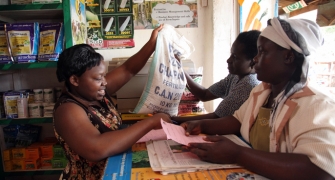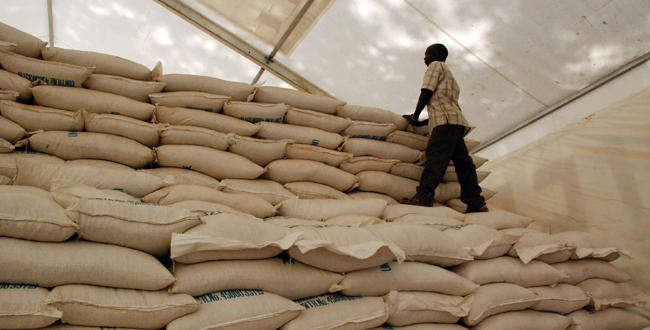Some 100,000 smallholder farmers in Eastern Kenya are now a step away from doubling household incomes through access to high quality farm inputs, and access to structured markets thanks to a transformatory venture aimed at improving food security and household income.
Dubbed Strengthening Agricultural Input and Output Markets in Africa, SAIOMA and chaperoned by the United State Agency for International Development (USAID) and the Alliance for a Green Revolution in Africa AGRA, the three year multi partner initiative adopts a wholistic approach from farm to folk by taking the weeping out of the current food production process and delivering the country from the yoke of hunger.
“ The SAIOMA initiative complements AGRA’s other market access initiatives and in Kenya we aim to work closely with county governments in Kitui, Meru North, Tharaka Nithi and Machakos, in alignment with their own agricultural growth priorities” said Anne Mbaabu, Director of Market Access Program, AGRA. The consortium implementing the initiative includes Agricultural Markets Development Trust AGMARK, Cereal Growers Association CGA, and Cooperative Consultancy Insurance Agency CCIA.
Previous interventions have only scratched the surface concentrating on one area of the value chain leaving farmers struggling to beat a litany of obstacles in food production. “Over the years, Kenya has made great strides in addressing smallholder farmers’ challenges, but alot much remains to be done, particularly in very remote areas, where access to inputs is still limited, uptake of agronomic practices remains low and transaction costs to access profitable output markets are high. I am therefore particularly pleased that this project seeks to address these challenges,” said Dr. Nyoro the Special advisor to the President of Kenya on agriculture during the launch of the project.
Access and availability of farm inputs have been every Kenyan farmer’s nightmare with poor seed quality affecting the overall yields and erratic fertilizer supply and cost affecting the planting and ultimately harvesting seasons. SAIOMA project cognizant of the role of seed access in food production is also targeting 550 agro dealers. The agro dealers will stem biting shortage of these inputs that have opened a tirade of effects and further fanning Kenya’s hunger cycle.
 Under the model the agro dealers will be trained and equipped to sustainably supply inputs to smallholder farmers, engage in grain bulking and aggregation while building capacity to allow them access financing to remain in business. Kenya snails the rest of the world in fertilizer use, which explains low productivity in the fields with average fertilizer application rate in the country standing at a dismal 13 kilograms per hectare compared with an average of 94 kilograms per hectare in other developing countries. This even as it emerges that low soil fertility and poor use of fertilizers is the key source of depressed yields in the country. Training of farmers on good use of fertilizer and other agronomic activites is a key theme in the SAIOMA programme.
Under the model the agro dealers will be trained and equipped to sustainably supply inputs to smallholder farmers, engage in grain bulking and aggregation while building capacity to allow them access financing to remain in business. Kenya snails the rest of the world in fertilizer use, which explains low productivity in the fields with average fertilizer application rate in the country standing at a dismal 13 kilograms per hectare compared with an average of 94 kilograms per hectare in other developing countries. This even as it emerges that low soil fertility and poor use of fertilizers is the key source of depressed yields in the country. Training of farmers on good use of fertilizer and other agronomic activites is a key theme in the SAIOMA programme.
But Kenyan farmers are also buffeted by poor post harvest storage which cost the continent over $4billion annually with losses and damages related to poor food storage mechanisms. In Kenya this post harvest losses accounting for over 40 to 50 percent of all income farmers lose.
SAIOMA hopes to arrest the situation through creation of warehouse receipting systems that would allow farmers to stock their harvested produce as they look for markets.
But it is the market aspect that is set to redefine farming in the target areas. Market vagaries, including glut, poor farm gate prices and exploitation by middle men have sounded the death knell on farmers’ incomes. Numerous studies indicate that farmers lose upto 20 percent of their farm earnings through long and unstructured markets. This income could go along way in motivating farmers to produce more, spurring farming for business ventures.
 SAIOMA hopes to make use of the warehouse receipting system to allow farmers stock their produce waiting for the right time when market forces favour them. The project also links the farmers with potential buyers allowing the farmers to have guaranteed market while giving them collective bargaining power. Traditionally farmers having harvested their produce at the same would crowd the market creating a glut which has resulted in poor prices.
SAIOMA hopes to make use of the warehouse receipting system to allow farmers stock their produce waiting for the right time when market forces favour them. The project also links the farmers with potential buyers allowing the farmers to have guaranteed market while giving them collective bargaining power. Traditionally farmers having harvested their produce at the same would crowd the market creating a glut which has resulted in poor prices.
“The AU has declared 2014 the year of Agriculture, this is the make it or break it year as far as agriculture is concerned. With projects like SAIOMA i am confident that we are on the right track in our march for a green revolution in Africa,” said Mrs Jane Karuku the President of AGRA.
The project has been hailed as having come at an opportune time when the country has stepped up its resolve to streamline the agricultural value chain by bridging hiccups that have stood in the way of optimum production by farmers. “Under Vision 2030, agriculture is identified as one of the key sectors to deliver the economic growth of 10 percent annual economic growth rate envisaged under the economic pillar. SAIOMA will directly contribute to Government priorities of increasing productivity, commercialization and competitiveness of agricultural commodities – which is one of two strategic thrusts of the Agricultural Sector Development Strategy (ASDS). SAIOMA interventions will improve access to markets for smallholder farmers through better supply chain management, and therefore directly addressing a priority intervention area of the Vision 2030,” said Dr. Nyoro.
The project is also being implemented in Zambia and Malawi.